Space: the Final Frontier
These are the voyages of the Starship, Enterprise
Its 5 year mission
To explore strange new worlds
To seek out new life and new civilizations
To boldly go where no man has gone before
Sixteen years before the first televised episode of "Star Trek" I heard the following words on Saturday mornings:
Space Patrol
ABC presents high adventure in the vast reaches of space
Missions of daring in the name of Interplanetary Justice
Travel into the future with Buzz Corey
Commander and Chief of the Space Patrol
This is a look at five television programs that took young viewers, like myself, into "the vast reaches of space" from 1949 through 1955. I was four months short of my third birthday when the first premiered and three months short of my ninth birthday when the last of the five left the airwaves.
These programs, even compared to the look of that very first "Star Trek" episode, were slapped together sometimes right at air time and were examples of the hit and misses of those early days of "Live" television programming. At times these shows reflected the politics of the Second World War and the dawning "Cold War", but all five only asked one thing of their young audiences and that was to use our imaginations and enjoy the ride.
Launched on August 15, 1946 is the now long forgotten "DuMont Television Network". Almost to the day ten years later on August 6, 1956 the network was no more. However, it has the distinction of running the first Science Fiction television program ever.
CAPTAIN VIDEO AND HIS VIDEO RANGERS
Premiering June 27, 1949 on DuMont and showing on Saturdays and Monday through Friday at 7 PM Eastern was "Captain Video and His Video Rangers". A series whose name reflected the medium it was being seen on and for a long time only had the Captain and three Video Rangers in the cast.
The opening narration:
CAPTAAAAAAAAIIIIN VIDEEEEOOOOOOOOOO! Master of time and space! Guardian of the safety of the world!
The premise was simple. The "Commissioner of Public Safety" who was responsible for the protection of all future Earth Citizens on the planet and in outer space would send orders to Video and his Rangers. It was there job to apprehend and stop the villains which were usually from planets within and without of our Solar System.
The program ran 30 minutes including commercials and what was probably a bathroom break my guess. As ten minutes into each program there would be seven minutes of an old "B" Western described by the Communications Officer Ranger Rodgers as a look at one of the Captain's "Undercover Agents" on Earth.
The Captain's base was located on top of an unknown mountain. Located there was his base Space Port and there was a second on a secret asteroid in deep space. The Space Port also made a great toy for young boys. Early television programs were discovering merchandising.
The space craft that the Captain and his Video Ranger flew were made of cardboard as were the craft of the villains. In the twentieth episode of the program the first space ship battle on live television took place. It was designed by the networks chief special effects artist Ed Wood. Yes, that Ed Wood and helped "Captain Video and His Video Rangers" earn an early Emmy. Another factor were the 12 writers on the program. Perhaps you would recognize two of their names Arthur C. Clarke and Isaac Asimov. In short the program was in very capable hands.
Another member of the show in several episodes was a robot. Typical of the problems with live television was that the robot was to have been named "Robot I (Robot One)", but in the rush to get the episode on air the stencil for that name which went on the robot's body was reversed. Instead of "Robot I" he became "I Tobor" and its name remained that way.
"Tobor" was so liked that he got his own movie "Tobor the Great" distributed by Republic Pictures which was unrelated to the television series.
The original role of Captain Video was played by Richard Coogan, but he left the program after he became disillusioned with the very low, low budget and the pace he had to keep up. Coogan was replaced by Al Hodge who held the part for the majority of the program's run from December 15, 1950 until the final episode on April 1, 1955.
Richard Googan as Captain Video
Al Hodge as Captain Video
So what about Richard Coogan's complaint about the show's budget? I already mentioned that the space ships were cardboard. The studio for the show was actually in a "Wanamaker's Department Store" in New York City. When the crew needed props they would just go into the store and find them. Shoot the scenes and return the items in many cases to be sold.
In the Studio:
There were many enemies usually from other planets and solar systems, but Captain Video's arch rival was Dr. Pauli. He usually wore pin stripes suits and spoke in the style of old movie Nazi's, or, at the time, Hollywood's version of the Soviet secret agent.
Pauli would die 36 times over the run of the show and just reappear when they needed the character.
Like many programs of the time you could join the "Video Rangers".
Sponsor's commercials were done live as suddenly the Captain, or a Video Ranger would turn to the viewing audience in at point in a scene and deliver the pitch. This was standard practice during the early television years.

Of course there were those special appearances:
Then like the Space Port there were the toys to get your mom and dad to buy using the power of the new medium television.
The game:
The comic books:
The records:
There were two spin offs from the original television show. One was another television program "The Secret Files of Captain Video" on Saturday mornings from September 5, 1953 through May 29, 1954 with Al Hodge again appearing as the Captain.
The above ad for Post Cereals mentioned the 1951 Columbia Pictures 15 Chapter serial "Captain Video: Master of the Stratosphere" starring Judd Holden as the Captain. The Captain and his rangers fight an evil space dictator from the planet Atoma known as Vultura. He is aided by an Earth scientist, you're going to love this, named Dr. Tobor.
I would love to tell you some of the plots for the original television show, but in 1970 the company that owned the DuMont library destroyed most of their programming to make more room. Only five episodes of the series is known to exist. They are available on YouTube.
However, the power of the program besides the two spin offs and merchandising can be shown by looking at old episodes of the Jackie Gleason, Audrey Meadows, Art Carney and Joyce Randolph classic television show "The Honeymooners". The inspiration for the Hanna/Barbera cartoon show "The Flintstones". Here are some stills of Art Carney as his character Ed Norton wearing a space helmet. Norton's favorite television show was "Captain Video". The program was originally on the DuMont Network, but this episode was on their new home CBS.

SPACE PATROL
I started this article by showing my readers the similarity between the opening lines for "Star Trek" and the opening lines for "Space Patrol". Space Patrol premiered on March 9, 1950 and was aimed at young audiences, but by 1954 was being listed in the "Top Ten" Saturday programs because the stories matured and the series had picked up a large adult audience. It was the most popular Sci-Fi show of the period.
The program was not in color, but those red outfits were designed to accent the black and white of live television programming. In this cast photo are two of the strong female characters the show introduced. Science Fiction television fans when mentioning "Star Trek" always brings up the fact that Gene Roddenberry introduced a racial integrated future. Praise should always be given to him, but when "Space Patrol", who Roddenberry mentioned as his inspiration, introduced two strong women of the future, Who went far against the established norm in America and on television.
The year was 1950 and a women's place was in the home taking care of the house, the children and her husband. This was the United States were the man was the "breadwinner" and the women the "housekeeper".
The following are the first four of the eighteen suggestions of the "Good Housewife's Guide" for the proper 1950's wife. The article was found in the May 1955 issue of the women's magazine "Good Housekeeping Monthly" five years after "Space Patrol" premiered,
1. Have dinner ready. Plan ahead, even the night before, to have a delicious meal ready, on time for his return. This is a way of letting him known you have been thinking about him and are concerned about his needs.
2. Most men are hungry when they come home and the prospect of a good meal (especially his favorite dish) is par of the warm welcome needed.
3. Prepare yourself. Take 15 minutes to rest so you will be refreshed when he arrives. Touch up your make up, put a ribbon in your hair and be fresh-looking. He has just been with a lot of work-weary people.
4. Be a little gay and a little more interesting for him. His boring day may need a lift and one of your duties is to provide it.
Here is a link to the complete "Good Housewife's Guide":
http://www.littlethings.com/1950s-good-housewife-guide-vas/
To back up where a women's place should be. I would remind my reader of those 1950's television sitcoms like "Ozzie and Harriet", "Father Knows Best" and "Leave It to Beaver". Where the wife is shown in her proper 1950's image.
So who were these future women of "Space Patrol"?
Blonde Actress, Virginia Hewett, played Carl Carlisle the daughter of the Secretary General of the United States. She worked in both administrative and scientific capacities at the United Planets Headquarters. Along with going on deep space missions with Commander Corry and his crew. It should be again noted that "The United Planets" of "Space Patrol" was identical in description to the "Federated Planets" of "Star Trek" as with the similar openings for the two programs.
Brunette Actress, Nina Bara, played "Tonga" once known as "The Lady of Diamond" an evil villain, "Tonga" is described on "Space Patrol" as eventually converting from the "Dark Side", hello George Lucas, and became the Chief Assistant to Major Robertson the Security Chief of the Space Patrol.
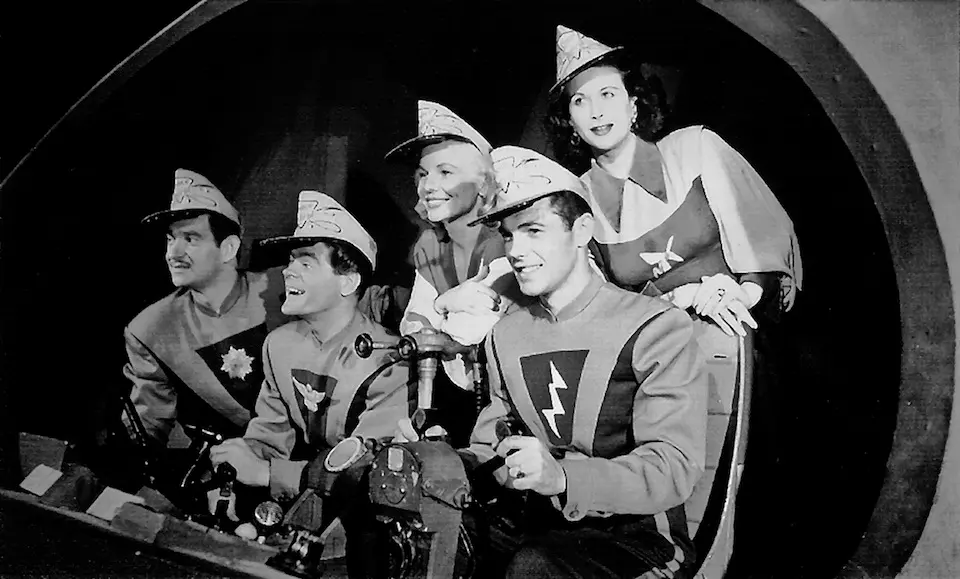
Ed Kemmer played "Buzz" Corry Commander and Chief of the Space Patrol. Kemmer was not the original leader. That was actor Glenn Denning as Kitt Corry the older brother of "Buzz". However, this was live television and Denning kept forgetting his lines and was replaced by the producers.
There are some similarities between Corry and Kirk, but Corry actually had more responsibilities. He was described as being the Space Patrol's Senior Officer whose assigned tasks included clearing and policing the space lanes, maintaining peace in the Galaxy and eventually exploring the outer regions of intergalactic space and time.
The comic relief was provided by actor Lyn Osborn as Cadet Happy Osborn. Nice choice of a last name, but the character actually reflected actor Osborn's personality. That's him pointing the ray gun, a cap pistol version I once had, at actresses Hewett and Bara.
The basic story lines in some cases were similar to "Captain Video" and when you're only the second such program on television the ideas would at times seem similar. "Space Patrol" took place in the 30th Century as the crew of the spaceship "Terra" fought interplanetary villains. Who of course might have Russian, or German accents as in "Captain Video". Both shows reflected the mood of America at the start of the "Cold War" and the enemies of "The United Planets". The last of the five programs in this article has an interesting twist to this aspect which you will read about later.
Originally the program was only 15 minutes on a local Los Angeles station, but when it moved to ABC it became 30 minutes in length and was seen on Saturday mornings, With that move came a larger budget. However, this was still live television and when their spaceship the "Terra" lifted off. The actors would lean way back in their chairs lifting the front off the floor. As they were shot from the waist up this gave motion was to give the impression that the spaceship was moving upwards.
Originally the program was only 15 minutes on a local Los Angeles station, but when it moved to ABC it became 30 minutes in length and was seen on Saturday mornings, With that move came a larger budget. However, this was still live television and when their spaceship the "Terra" lifted off. The actors would lean way back in their chairs lifting the front off the floor. As they were shot from the waist up this gave motion was to give the impression that the spaceship was moving upwards.
A radio version of the program with the cast was started, but it didn't do as well. The reason television was taking away those radio faithful.
"Space Patrol" made television history in two ways. It was the first West Coast network program broadcast to the East Coast. At the time a major accomplishment, because such cross country technology was truly in its infancy and designed to work from East to West.
Then on April 29, 1953 "Space Patrol" was test shown in an experimental 3-D television process. This was on ABC Los Angeles affiliate KECA-TV which the following year became the present KABC Channel 7. It was an interesting idea that didn't completely work.
How about these large television sets berlow?
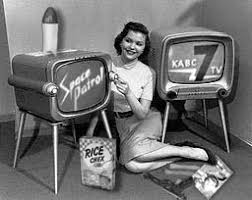
Unlike "Captain Video and his Video Rangers" being televised from a small area in a Department Store. The stage used for "Space Patrol" had been the one originally used to film Lon Chaney's silent classic "The Phantom of the Opera" at Universal Studios. Allowing for a lot of more intricate sets than any of the other four science fiction shows I will mention in this article.
I mentioned I could become a "Video Ranger" earlier. Here is the package young viewers and I received when we joined "The Space Patrol".

Speaking about Marketing. The cereal company Ralston-Purina really got into the act. The first pictures are of the Ralston-Purina Space Patrol rocket that went across the country and would have members of the cast to meet and greet fans.
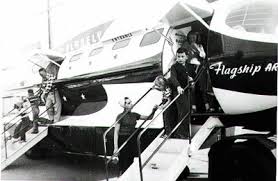
How about other premiums from Ralston-Purina?
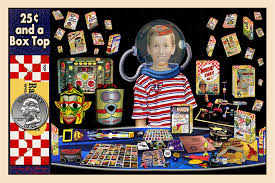
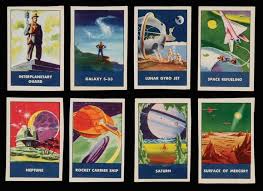
How about those toys your parents could buy you?
You could get the official "Space Patrol" helmet and ray gun.
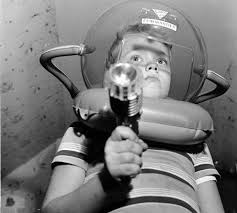
There was also a model of the "Terra".
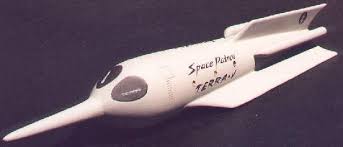
"Space Patrol" was one of the first children's television programs to come out with a watch.

Want to speak to other Patrol members?
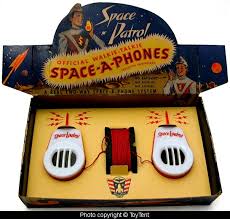
Even with sentiment still running against Japan and the Japanese from World War Two. Japanese toy makers found a new market with the television show "Space Patrol".
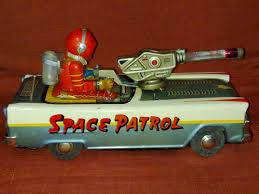
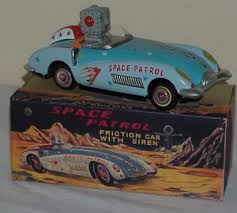
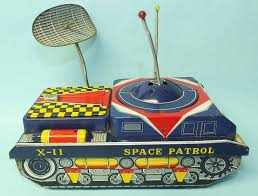
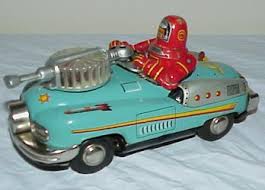
Can't forgot those 10 cent comic books.


You can tell why being me in the 1950's was fun and that is only a sampling of the toys for this program. There were also the comic books and records to purchase.
Now, if you think the show was only seen in the United States. Think again as this ad from the U.K. for program merchandise clearly shows:
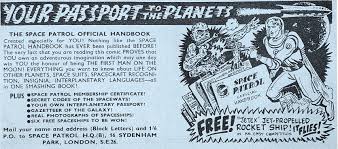
I have a fond memory of going to the Carthay Circle Theater for a "March of Dimes" telethon and meeting all the cast members from "Space Patrol". At the time I was given a bank shaped like the "Terra" to save more dimes for next year's telethon. The last episode of "Space Patrol" was televised on ABC on February 26, 1955.
Many television historians consider "Space Patrol" as the "Grandfather" of "Star Trek". Just as Burt Lancaster's pirate movie "The Crimson Pirate" makes Lancaster's Captain Vallow the "Grandfather" figure of Johnny Depp's "Jack Sparrow" to Depp and motion picture historians. From just the little I have mentioned a reader can see why "Space Patrol" is considered with more than a passing foot note.
For those of you who might be interested. Episodes of "Space Patrol" can be found on YouTube and on DVD.
TOM CORBETT SPACE CADET
Another major television program of the period was "Tom Corbett Space Cadet". It was about three young Space Cadets who wanted to become members of the "Solar Guard", The Solar Guard was the interplanetary police force that protected the colonists from Earth on other planets and those planets original populations as well. The three have applied to the "Space Academy" the most prestigious school in the Solar System and hardest to enter. The show's young audience follows Corbett played by Frankie Thomas, Jr, Astro who was born on Venus played by Al Markin and Roger Manning played by Jan Merlin through training and on cadet missions on board their space ship the "Polaris". As they become known as "Team Polaris".
Of the five programs I used to watch each week. "Tom Corbett Space Cadet" was the only one scientifically accurate in every detail about Space Travel and what scientists believed the solar system was like when it premiered. The show was on the air from October 2, 1950 through the final episode on June 25, 1955 and kept that scientific accuracy which today seems laughable, like humans living on Astro's home planet of Venus, through all five years of its run.
The reason for this accuracy was that unlike the previous two programs "Tom Corbett Space Cadet" had a scientific adviser named Willy Ley. Who would also co-author, under a pen name, some of the scripts and all eight novels between 1952 and 1956 which are still available.
So who was Willy Ley? Ley was a German/American science writer and a strong proponent of space flight. He worked with Wernher Von Braun on several projects and was behind the science of Walt Disney's 1955 "Man In Space" episode for the television program "Disneyland". Ley wrote a major speculative work in 1949 on space exploration "Conquest of Space" which is still sought after. He also wrote for the non-fiction science magazine "Other Worlds Science" as well as writing science fiction stories for the magazine "Galaxy Science Fiction".

Along with Robert A. Heinlein Willy Ley co-authored the script for George Pal's Academy Awarding winning 1950 motion picture "Destination Moon" based upon a Heinlein story. The film with its accurate for the year depiction of space travel inspired future astronauts "Buzz" Aldrin and Neil Armstrong about what careers they wanted. Ley's work "Conquest of Space" became the scientifically accurate 1955 George Pal film "The Conquest of Space". The only difference in the means for deep space travel described by Ley for that movie and Stanley Kubrick's "2001: A Space Odyssey" thirteen years later was what type of food the space explorers would eat. In 1955 the food was in pill form while in 1968 the food were synthetics.
So with Ley behind the stories and technical aspects of "Tom Corbett Space Cadet" the show won praise from the scientific community and other organizations.
To illustrate the fluidity of shows in the early television years. This is the televised history of the program.
It started on CBS and ran from October 2, 1950 to the end of December 1950. The show then moved to ABC and ran there from January 1951 through September 1952. However, during this same period NBC ran different episodes from July 1951 through September 1951 as a summer replacement. So it was on two major networks at the same time. The show went off air for a year, but the public demand brought it back. The role of Roger Manning had been cut as Jan Merlin had found other work and he was replaced by Jack Grimes as Cadet Tristle. "Tom Corbett Space Cadett" now moved to a fourth network DuMont from August 1953 through May 1954. NBC once again picked up the show and it ran for from December 1954 through its final episode on June 25, 1955. Strange as it sounds it was not unusual for a program of the period to appear on different networks. In the case of ABC it was originally the old NBC "Blue Network", they had other color coded networks in different parts of the country, sold off.


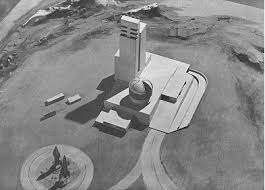
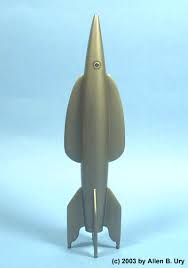
Like "Space Patrol" "Tom Corbett Space Cadet" had a very strong female character in Dr. Joan Dale. Below a photo of Tom and Dr. Dale played by Margaret Garland. Dr. Dale was a major "Solar Guard" scientist and took over command of the "Space Academy" when needed. She is also the love interest of Captain Steve Strong played by Edward Bryce. For a short time Pat Ferris played Dr. Dale, but Garland returned.

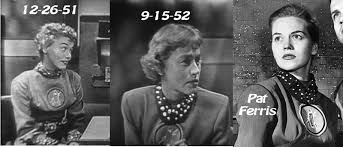


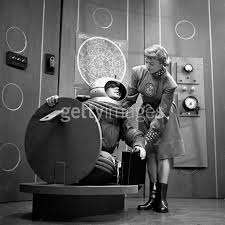

Besides the eight novels I mentioned there were the Daily and Sunday newspaper comic strips of Tom Corbett which ran from September 9, 1951 through February 8, 1953.
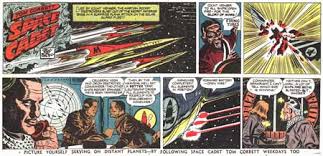
Then there was the shows cereal sponsor. Post had "Captain Video", Ralston-Purina had "Space Patrol" and now Kellogg joined in with "Tom Corbett".
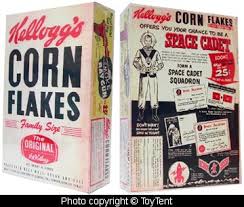
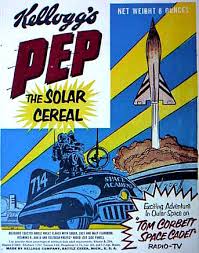

As with the other shows and children's television in general there were the comic books. Dell ran Tom Corbett comics from February 1952 through November 1954, Prize Comics ran then May 1955 through October 1955 and Eternity Comics released three updated comic books in 1990. Showing how popular the character had remained.


Of course there were those great toys that kept a kid's imagination going. Back in the 1950's a kid couldn't get mistaken for carrying a real gun, but who needed a copy of an AK-47 when you had atomic powered weapons?
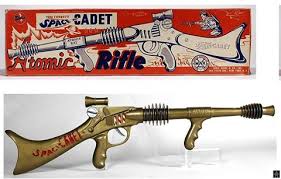
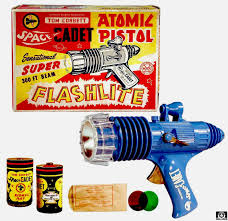
Any true Space Cadet needed a belt and googles.
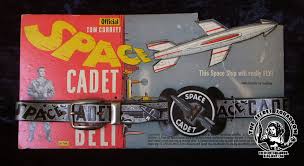
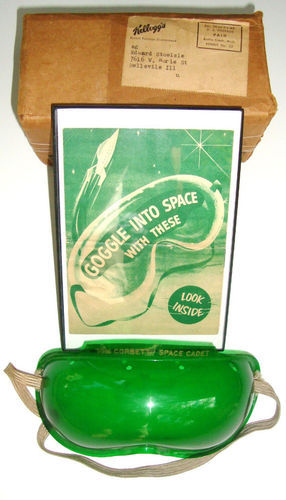
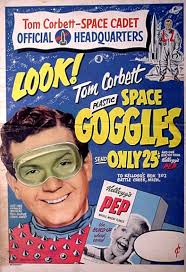
However, "Tom Corbett Space Cadet" was the first television show designed for boys that thought of the girls watching also and created dolls, because there were girl space cadets.

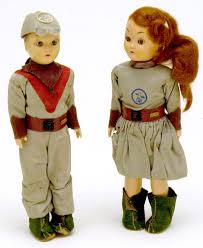
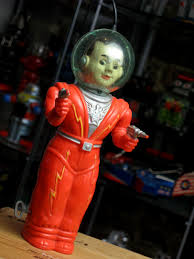
My favorite item was the space helmet from the show. As you can see nobody could look in at your face, but you clearly saw out.


Episodes of "Tom Corbett Space Cadet" can be found on both YouTube and DVD's.
ROCKY JONES SPACE RANGER

Nothing like using cost cutting white undershirts for costumes.
The plot may seem somewhat similar between Rocky Jones and Tom Corbett. As both shows "borrowed" their main idea from Robert A. Heinlein's 1948 novel "Space Cadet" about Matt Dodson who joins the "Space Patrol" and is accepted as a Cadet. Even though the novel was about the "Space Patrol" it was not used for that series as source material.
The program was the creation of Robert D. Reed the producer of a major family show of the period "My Little Margie". "My Little Margie" was about a 50 year old widowed father watching over his 21 year old daughter and the problems, some very comical, she was confronted with. That short show description gives my read Reed's mind set toward what he wanted to see on the screen.
Rocky Jones is the most known Space Ranger in the Universe. Rocky along with his crew would leave their Earth base for interstellar adventures at the direction of Professor Newton of the United Worlds, or Secretary Drake the head of the "Office of Space Affairs". Although they might destroy another space ship in a battle. As another cost cutting decision its destruction was never shown on the screen. When the crew confronted their opponents they never drew their weapons, or fired a gun. It was always a hand to hand ":fair" fist fight. Like "The Lone Ranger" of the same period. Rocky Jones had a high moral standard he followed and like that other program his character was designed as a role model for young boys and girls by Robert D. Reed.
"Rocky Jones Space Ranger" unlike the above three space shows was shot on film for syndication and was not shown on what was becoming the three major networks. However, as a result of a being filmed all 39 episodes of the series are available today for viewing. |
As this was a syndicate television series "Rocky Jones Space Ranger" first ran from February 1954 through January 1955. Although there were only 36 episodes filmed. That time period was based upon the date the series first premiered on a television station in syndication and the last date the complete 36 episodes ended at the last station it played during that first run.
The 36 episodes were actually grouped into three part stories and some became edited into movie versions. Two of those "Clash of Moons" and "Manhunt in Space" were lampooned on "Mystery Science Theater 3000", Most of the episodes are available on YouTube.




Richard Crane played Rocky Jones. Whom as I said was the perfect 1950's action hero. Jones is described as brave, strong, handsome, highly moral and always ready to defend his beliefs with quick, but decisive action. Beliefs which were those of the United States at the time. Rocky also had no problems attracting lovely ladies even if some were alien villains.
For the first 26 episodes Rocky's comic sidekick was "Winky" played by Scotty Beckett. Beckett was one of the original "Our Gang" kids and as he grew up found himself cast as the younger version of the hero in major movies. Such as Errol Flynn's in the "Charge of the Light Brigade". in the controversial 1942 "Kings Row" he played Robert Cummings character as a child and in the major 1946 musical biography young Al Jolson in "The Jolson Story" before getting the role of "Winky". The reason he was only in the first 26 episodes was that Beckett had been jailed for a concealed weapons charge and also had drug addiction problems. Scotty Beckett is on the left in the following photo with Richard Crane. Beckett was replaced for the final 13 episodes with Jimmy Lydon as Biffen Cardoza. I could not locate a still from the show of Lydon, but here is a photo below the first of him on another television program.


What is interesting is that Richard Crane would play the semi-comic sidekick Dick Preston to Judd Holden in the Republic 1955 television series on NBC "Commando Cody Sky Marshall of the Universe". I am emphasizing that this was the television series, because in 1953 Judd Holden starred in a 12 chapter Republic serial of the same name. The television program was constructed that same 12 part serial with added footage and characters including Crane's. I loved Commando Cody, because he wore the same flying suit and used the same rocket ships seen in three other Republic Pictures serials 1949's "King of the Rocket Men", 1952's "Radar Men from the Moon" and 1952's "Zombies of the Stratosphere" with a young Leonard Nimoy as a Martian Zombie. "Live Long and Prosper" Mr. Spock and RIP.

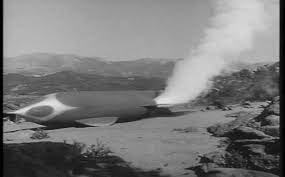

Above Holden, Crane and Aline Towne from the extended television version of Commando Cody. I also remember that Richard Crane played the pilot of Commando Cody's hidden spaceship.
Returning to "Rocky Jones Space Ranger".
This program had a very strong female lead played by actress Sally Mansfield. Her character Vena Ray had two important positions on any space mission. She was the navigator for Rocky Jones and his translator when it was needed. Once more not the normal picture of a women in 1950's America as in programs like "December Bride" and "The Danny Thomas Show".
Here's an interesting point about Mansfield's contract and that of Richard Crane's which definitely goes to the moral values of the period. Both Crane and Mansfield were given five year contracts for the program by co-producer Guy V. Thayer, Jr. Her's stipulated that she could not marry for the next five years. Probably a move to hopefully eliminate the possibility of Mansfield getting pregnant and leaving the program. As for Richard Crane he could not divorce his wife of the past eight years. Equating him to his character's high 1950's moral standards and that role model status the producers wanted.
Then there were the two female villains. One Cleolanta was Suzerain (Feudal Lord) of the planet Ophecius. Cleolanta was always giving the United Worlds problems, but also was in love with Jones. Cleolanta was played by Patsy Parsons.


Ann Robinson had the dual role of the good sister Suzerain Juliandra of the planet Herculon. She was also Juliandra's imprisoned mad twin sister who hates the United World's. My readers may recognize the actresses name as Ann Robinson played Gene Barry's love interest Sylvia van Buren in George Pal's Oscar Winning 1953 science fiction classic "War of the Worlds". Here is a photo of both Barry and Robinson as they appeared in the Pal motion picture.
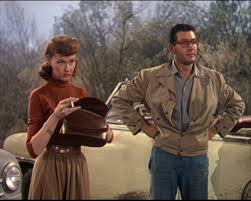
As a tribute to the original both actors appeared as the Grandparents seen at the very end of Steven Spielberg's version of the H.G. Well's story.
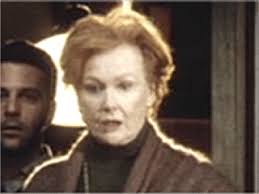
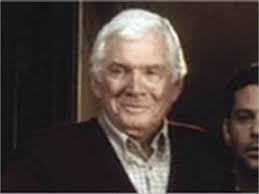
Here is Ann Robinson as she appeared on "Rocky Jones Space Ranger".


Before the show even aired a merchandising blitz was started to promote it across the country. However, this could not equate to the other programs, because simply put this was a syndicated show which was never guaranteed a television station to appear upon and without local stations signed up the producers couldn't promote their program as strongly as needed. On the other hand in different markets local sponsors did take over.
.
One of the sponsors was the Gordon Bakery Company out of Michigan. They went so far as to build a spaceship to promote both the show and their "Silvercup Bread". Then the rocket ship would be taken on the State and Local Fair Circuits, minus any of the cast members, in Michigan and its surrounding states that the company sold their products..

The rocket in 1980 on a farm in Michigan.
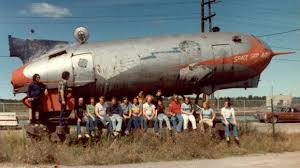
Syndication did not hinder a merchandise marketing program even in areas that show was not being seen. As with the other shows is the "Rocky Jones Space Ranger".


Then there were Rocky Jones membership items like these great wings.
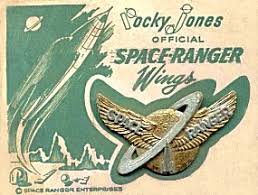
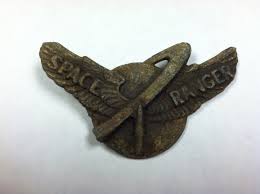
Of course the comic books sold nationwide.

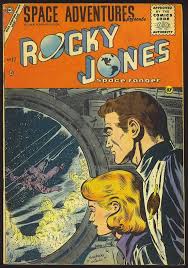
"Space Patrol" made television history in two ways. It was the first West Coast network program broadcast to the East Coast. At the time a major accomplishment, because such cross country technology was truly in its infancy and designed to work from East to West.
Then on April 29, 1953 "Space Patrol" was test shown in an experimental 3-D television process. This was on ABC Los Angeles affiliate KECA-TV which the following year became the present KABC Channel 7. It was an interesting idea that didn't completely work.
How about these large television sets berlow?
Unlike "Captain Video and his Video Rangers" being televised from a small area in a Department Store. The stage used for "Space Patrol" had been the one originally used to film Lon Chaney's silent classic "The Phantom of the Opera" at Universal Studios. Allowing for a lot of more intricate sets than any of the other four science fiction shows I will mention in this article.
I mentioned I could become a "Video Ranger" earlier. Here is the package young viewers and I received when we joined "The Space Patrol".
Speaking about Marketing. The cereal company Ralston-Purina really got into the act. The first pictures are of the Ralston-Purina Space Patrol rocket that went across the country and would have members of the cast to meet and greet fans.
How about other premiums from Ralston-Purina?
How about those toys your parents could buy you?
You could get the official "Space Patrol" helmet and ray gun.
There was also a model of the "Terra".
"Space Patrol" was one of the first children's television programs to come out with a watch.

Want to speak to other Patrol members?
Even with sentiment still running against Japan and the Japanese from World War Two. Japanese toy makers found a new market with the television show "Space Patrol".
Can't forgot those 10 cent comic books.
You can tell why being me in the 1950's was fun and that is only a sampling of the toys for this program. There were also the comic books and records to purchase.
Now, if you think the show was only seen in the United States. Think again as this ad from the U.K. for program merchandise clearly shows:
I have a fond memory of going to the Carthay Circle Theater for a "March of Dimes" telethon and meeting all the cast members from "Space Patrol". At the time I was given a bank shaped like the "Terra" to save more dimes for next year's telethon. The last episode of "Space Patrol" was televised on ABC on February 26, 1955.
Many television historians consider "Space Patrol" as the "Grandfather" of "Star Trek". Just as Burt Lancaster's pirate movie "The Crimson Pirate" makes Lancaster's Captain Vallow the "Grandfather" figure of Johnny Depp's "Jack Sparrow" to Depp and motion picture historians. From just the little I have mentioned a reader can see why "Space Patrol" is considered with more than a passing foot note.
For those of you who might be interested. Episodes of "Space Patrol" can be found on YouTube and on DVD.
TOM CORBETT SPACE CADET
Another major television program of the period was "Tom Corbett Space Cadet". It was about three young Space Cadets who wanted to become members of the "Solar Guard", The Solar Guard was the interplanetary police force that protected the colonists from Earth on other planets and those planets original populations as well. The three have applied to the "Space Academy" the most prestigious school in the Solar System and hardest to enter. The show's young audience follows Corbett played by Frankie Thomas, Jr, Astro who was born on Venus played by Al Markin and Roger Manning played by Jan Merlin through training and on cadet missions on board their space ship the "Polaris". As they become known as "Team Polaris".
Of the five programs I used to watch each week. "Tom Corbett Space Cadet" was the only one scientifically accurate in every detail about Space Travel and what scientists believed the solar system was like when it premiered. The show was on the air from October 2, 1950 through the final episode on June 25, 1955 and kept that scientific accuracy which today seems laughable, like humans living on Astro's home planet of Venus, through all five years of its run.
The reason for this accuracy was that unlike the previous two programs "Tom Corbett Space Cadet" had a scientific adviser named Willy Ley. Who would also co-author, under a pen name, some of the scripts and all eight novels between 1952 and 1956 which are still available.
So who was Willy Ley? Ley was a German/American science writer and a strong proponent of space flight. He worked with Wernher Von Braun on several projects and was behind the science of Walt Disney's 1955 "Man In Space" episode for the television program "Disneyland". Ley wrote a major speculative work in 1949 on space exploration "Conquest of Space" which is still sought after. He also wrote for the non-fiction science magazine "Other Worlds Science" as well as writing science fiction stories for the magazine "Galaxy Science Fiction".

Along with Robert A. Heinlein Willy Ley co-authored the script for George Pal's Academy Awarding winning 1950 motion picture "Destination Moon" based upon a Heinlein story. The film with its accurate for the year depiction of space travel inspired future astronauts "Buzz" Aldrin and Neil Armstrong about what careers they wanted. Ley's work "Conquest of Space" became the scientifically accurate 1955 George Pal film "The Conquest of Space". The only difference in the means for deep space travel described by Ley for that movie and Stanley Kubrick's "2001: A Space Odyssey" thirteen years later was what type of food the space explorers would eat. In 1955 the food was in pill form while in 1968 the food were synthetics.
So with Ley behind the stories and technical aspects of "Tom Corbett Space Cadet" the show won praise from the scientific community and other organizations.
To illustrate the fluidity of shows in the early television years. This is the televised history of the program.
It started on CBS and ran from October 2, 1950 to the end of December 1950. The show then moved to ABC and ran there from January 1951 through September 1952. However, during this same period NBC ran different episodes from July 1951 through September 1951 as a summer replacement. So it was on two major networks at the same time. The show went off air for a year, but the public demand brought it back. The role of Roger Manning had been cut as Jan Merlin had found other work and he was replaced by Jack Grimes as Cadet Tristle. "Tom Corbett Space Cadett" now moved to a fourth network DuMont from August 1953 through May 1954. NBC once again picked up the show and it ran for from December 1954 through its final episode on June 25, 1955. Strange as it sounds it was not unusual for a program of the period to appear on different networks. In the case of ABC it was originally the old NBC "Blue Network", they had other color coded networks in different parts of the country, sold off.
Like "Space Patrol" "Tom Corbett Space Cadet" had a very strong female character in Dr. Joan Dale. Below a photo of Tom and Dr. Dale played by Margaret Garland. Dr. Dale was a major "Solar Guard" scientist and took over command of the "Space Academy" when needed. She is also the love interest of Captain Steve Strong played by Edward Bryce. For a short time Pat Ferris played Dr. Dale, but Garland returned.

Besides the eight novels I mentioned there were the Daily and Sunday newspaper comic strips of Tom Corbett which ran from September 9, 1951 through February 8, 1953.
Then there was the shows cereal sponsor. Post had "Captain Video", Ralston-Purina had "Space Patrol" and now Kellogg joined in with "Tom Corbett".
As with the other shows and children's television in general there were the comic books. Dell ran Tom Corbett comics from February 1952 through November 1954, Prize Comics ran then May 1955 through October 1955 and Eternity Comics released three updated comic books in 1990. Showing how popular the character had remained.
Of course there were those great toys that kept a kid's imagination going. Back in the 1950's a kid couldn't get mistaken for carrying a real gun, but who needed a copy of an AK-47 when you had atomic powered weapons?
Any true Space Cadet needed a belt and googles.

However, "Tom Corbett Space Cadet" was the first television show designed for boys that thought of the girls watching also and created dolls, because there were girl space cadets.
My favorite item was the space helmet from the show. As you can see nobody could look in at your face, but you clearly saw out.

Episodes of "Tom Corbett Space Cadet" can be found on both YouTube and DVD's.
ROCKY JONES SPACE RANGER
Nothing like using cost cutting white undershirts for costumes.
The plot may seem somewhat similar between Rocky Jones and Tom Corbett. As both shows "borrowed" their main idea from Robert A. Heinlein's 1948 novel "Space Cadet" about Matt Dodson who joins the "Space Patrol" and is accepted as a Cadet. Even though the novel was about the "Space Patrol" it was not used for that series as source material.
The program was the creation of Robert D. Reed the producer of a major family show of the period "My Little Margie". "My Little Margie" was about a 50 year old widowed father watching over his 21 year old daughter and the problems, some very comical, she was confronted with. That short show description gives my read Reed's mind set toward what he wanted to see on the screen.
Rocky Jones is the most known Space Ranger in the Universe. Rocky along with his crew would leave their Earth base for interstellar adventures at the direction of Professor Newton of the United Worlds, or Secretary Drake the head of the "Office of Space Affairs". Although they might destroy another space ship in a battle. As another cost cutting decision its destruction was never shown on the screen. When the crew confronted their opponents they never drew their weapons, or fired a gun. It was always a hand to hand ":fair" fist fight. Like "The Lone Ranger" of the same period. Rocky Jones had a high moral standard he followed and like that other program his character was designed as a role model for young boys and girls by Robert D. Reed.
"Rocky Jones Space Ranger" unlike the above three space shows was shot on film for syndication and was not shown on what was becoming the three major networks. However, as a result of a being filmed all 39 episodes of the series are available today for viewing. |
As this was a syndicate television series "Rocky Jones Space Ranger" first ran from February 1954 through January 1955. Although there were only 36 episodes filmed. That time period was based upon the date the series first premiered on a television station in syndication and the last date the complete 36 episodes ended at the last station it played during that first run.
The 36 episodes were actually grouped into three part stories and some became edited into movie versions. Two of those "Clash of Moons" and "Manhunt in Space" were lampooned on "Mystery Science Theater 3000", Most of the episodes are available on YouTube.
Richard Crane played Rocky Jones. Whom as I said was the perfect 1950's action hero. Jones is described as brave, strong, handsome, highly moral and always ready to defend his beliefs with quick, but decisive action. Beliefs which were those of the United States at the time. Rocky also had no problems attracting lovely ladies even if some were alien villains.
For the first 26 episodes Rocky's comic sidekick was "Winky" played by Scotty Beckett. Beckett was one of the original "Our Gang" kids and as he grew up found himself cast as the younger version of the hero in major movies. Such as Errol Flynn's in the "Charge of the Light Brigade". in the controversial 1942 "Kings Row" he played Robert Cummings character as a child and in the major 1946 musical biography young Al Jolson in "The Jolson Story" before getting the role of "Winky". The reason he was only in the first 26 episodes was that Beckett had been jailed for a concealed weapons charge and also had drug addiction problems. Scotty Beckett is on the left in the following photo with Richard Crane. Beckett was replaced for the final 13 episodes with Jimmy Lydon as Biffen Cardoza. I could not locate a still from the show of Lydon, but here is a photo below the first of him on another television program.
What is interesting is that Richard Crane would play the semi-comic sidekick Dick Preston to Judd Holden in the Republic 1955 television series on NBC "Commando Cody Sky Marshall of the Universe". I am emphasizing that this was the television series, because in 1953 Judd Holden starred in a 12 chapter Republic serial of the same name. The television program was constructed that same 12 part serial with added footage and characters including Crane's. I loved Commando Cody, because he wore the same flying suit and used the same rocket ships seen in three other Republic Pictures serials 1949's "King of the Rocket Men", 1952's "Radar Men from the Moon" and 1952's "Zombies of the Stratosphere" with a young Leonard Nimoy as a Martian Zombie. "Live Long and Prosper" Mr. Spock and RIP.
Above Holden, Crane and Aline Towne from the extended television version of Commando Cody. I also remember that Richard Crane played the pilot of Commando Cody's hidden spaceship.
Returning to "Rocky Jones Space Ranger".
This program had a very strong female lead played by actress Sally Mansfield. Her character Vena Ray had two important positions on any space mission. She was the navigator for Rocky Jones and his translator when it was needed. Once more not the normal picture of a women in 1950's America as in programs like "December Bride" and "The Danny Thomas Show".
Here's an interesting point about Mansfield's contract and that of Richard Crane's which definitely goes to the moral values of the period. Both Crane and Mansfield were given five year contracts for the program by co-producer Guy V. Thayer, Jr. Her's stipulated that she could not marry for the next five years. Probably a move to hopefully eliminate the possibility of Mansfield getting pregnant and leaving the program. As for Richard Crane he could not divorce his wife of the past eight years. Equating him to his character's high 1950's moral standards and that role model status the producers wanted.
Then there were the two female villains. One Cleolanta was Suzerain (Feudal Lord) of the planet Ophecius. Cleolanta was always giving the United Worlds problems, but also was in love with Jones. Cleolanta was played by Patsy Parsons.
Ann Robinson had the dual role of the good sister Suzerain Juliandra of the planet Herculon. She was also Juliandra's imprisoned mad twin sister who hates the United World's. My readers may recognize the actresses name as Ann Robinson played Gene Barry's love interest Sylvia van Buren in George Pal's Oscar Winning 1953 science fiction classic "War of the Worlds". Here is a photo of both Barry and Robinson as they appeared in the Pal motion picture.
As a tribute to the original both actors appeared as the Grandparents seen at the very end of Steven Spielberg's version of the H.G. Well's story.
Here is Ann Robinson as she appeared on "Rocky Jones Space Ranger".

Before the show even aired a merchandising blitz was started to promote it across the country. However, this could not equate to the other programs, because simply put this was a syndicated show which was never guaranteed a television station to appear upon and without local stations signed up the producers couldn't promote their program as strongly as needed. On the other hand in different markets local sponsors did take over.
.
One of the sponsors was the Gordon Bakery Company out of Michigan. They went so far as to build a spaceship to promote both the show and their "Silvercup Bread". Then the rocket ship would be taken on the State and Local Fair Circuits, minus any of the cast members, in Michigan and its surrounding states that the company sold their products..
The rocket in 1980 on a farm in Michigan.
Syndication did not hinder a merchandise marketing program even in areas that show was not being seen. As with the other shows is the "Rocky Jones Space Ranger".
Then there were Rocky Jones membership items like these great wings.
Of course the comic books sold nationwide.
But because the producers couldn't keep the show going in syndication for even one full year. Let alone the five years of Richard Crane's and Sally Mansfield's contracts. "Rocky Jones Space Ranger" went into obscurity for decades.
FLASH GORDON
Alex Raymond created "Flash Gordon" in 1934 as a comic strip for "King Features" to be syndicates in nationwide newspapers. Buster Grabbe played him in three popular serials from 1936 through 1940. From October 15, 1954 through July 15, 1955 a single season television series ran on the DuMont Network on the East Coast and in syndication in the rest of the United States. This wasn't the "Flash Gordon" of either Raymond, or Crabbe, but of the "Cold War" with politics clearly showing through.
To start this was a co-production of the United States, West Germany now our ally and France. The filming of the first 26 episodes were mostly shot in West Berlin. Which meant the four actor American cast and some of the crew were flown over Soviet Union controlled East Germany to a city that had once been the German Capital, but was now split in two The "Berlin Wall" would not be built until 1961. The final 13 episodes of "Flash Gordon" would be shot in Marseille, France.
Playing Flash Gordon was male model Steve Holland.
Holland appeared in a cameo in the 1953 Gary Cooper motion picture "The Court Marshall of Billy Mitchell" his only other acting role. Steve Holland is best known for two modeling positions. The first being the cover model for Fawcett Comics western series "Bob Colt".
The second was modeling work was for the 1970's reprints of Lester Dent's "Doc Savage" series.
Playing Dale Arden was actress Irene Champlin. Vincent Terrace in his 2002 work: "Crime Fighting Heroes of Television described Champlin's Dale Arden as:
quick thinker who often saved [Flash and Dr. Zarkov] from perishing.
:
A far cry from from the comic strip and Buster Crabbe serials "Damsel in Distress". Champlin would only act two more times after the series ended.
Joseph Nash played Dr. Hans Zarkov the scientist who in the original stories kidnaps Flash and Dale to help him stop the destruction of Earth from the planet Mongo under its ruler "Ming the Merciless" Other than this series all I could find out about this actor was in appeared in a 1951 crime drama "The Great Merlini" as the Head Waiter and as himself in 1997 on the television series "Biography" in an episode about the character of "Flash Gordon".
The last American actor in the cast was Henry Beckman as Commander Richards. Of the four actors in "Flash Gordon" Beckman is the only one that seems to have had an actual acting career before and after the series. He would appear on such television shows as "In Fenster, He's Fenster", the television soap based on the book "Peyton Place", "McHale's Navy" and the feature "McHale's Navy Joins the Air Force", "Gunsmoke", "Happy Days" and many other television programs and movies totaling 195 appearances from 1951 through 2002.
Which brings us to the fact that the majority of the cast members were from West Germany and as director Wallace Worsely, Jr said:
No matter what galaxy we explored, everyone spoke with a German accent. The use of German actors who could not speak English required us to use a lot of close-ups. I would stand behind the camera, correctly positioned for the actor's look, and read his or her line; the actor would then repeat the line, mimicking my pronunciation and emphasisAlthough the series was suppose to be taking place in the year 3203. The exterior shots were a striking remainder of the Second World War as the actors walked in the ruins of Berlin on the Allied side.
Note the background with the remains of a building and in front a pile of rumble. This was no set. This was West Berlin.
As to the quality of the production the series was so low budgeted that it used a lot of stock footage. However, at times these produced interesting results from a strictly "Political" "Cold War" sense.
There is a three part story consisting of:
The Witch of Neptune shown March 4, 1955 in the United States
The Brain Machine shown March 11, 1955 and
Struggle to the End shown March 18, 1955
The basic plot is that Zydereen the Witch of Neptune plans to take over the Earth and in good "Cold War" technique "Brain Washes" Dr, Zarkov and Commander Richards. It is up to Flash and Dale to save the day.
Above the only guest American on the series. Marie Powers as Zydereen the Witch of Neptune
In the second part "The Brain Machine" there is a scene of a panic on Neptune. It is the stock footage that was used that interests us. It was taken from news footage filmed on June 17, 1953 of East German workers demonstrating against the East German government. What American viewers didn't get, but West German's did when this sequence was shown. Is that the reason these workers are running in panic was because Soviet Tanks had opened fire upon them in one of the first demonstrations of Russia's control over that part of Germany.
While most reviewers skip the series as even existing. I read two internet articles on the history of the character of "Flash Gordon" and the 1954 to 1955 show is never mentioned, or even alluded too. The program was full of "Capitalistic" scenarios and other "Cold War" references. It is available on YouTube and DVD and is an interesting "Relic" of the early "Cold War" era.
These five early Science Fiction programs about Space Exploration must be taken in the context of the time they came out. At the time we had no idea what was or was not out there, but we had our imaginations. Sputnik was not launched by the Soviet Union until October 4, 1957. Two years after the last of these five shows aired. Yuri Gagarin's space flight as the first man to circle the Earth didn't take place until April 12, 1961. Six years after these five shows were on the air.
Today we seem to look for reality even in the games and television shows we watch. Technological progress is a fact, but ever so often we need to step back in time and look at the wonderment of the dreamers of the past. I hope you enjoyed your trip.




No comments:
Post a Comment